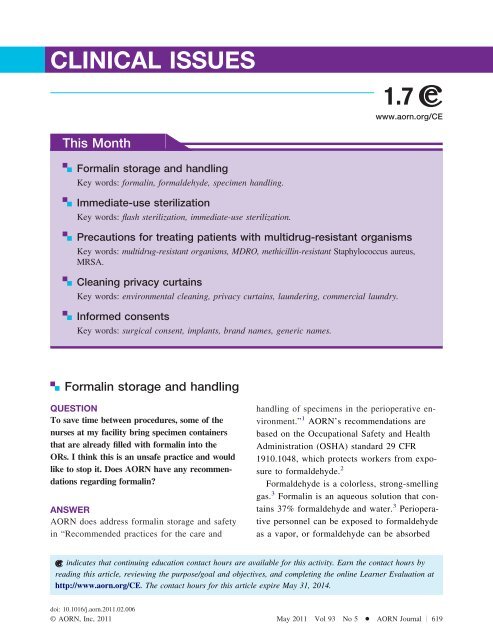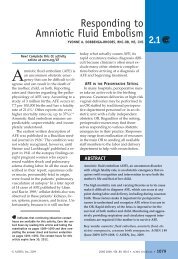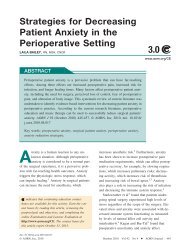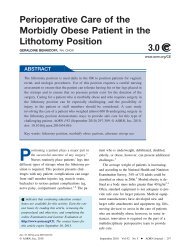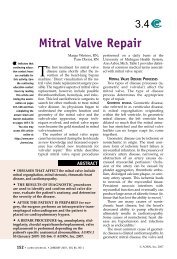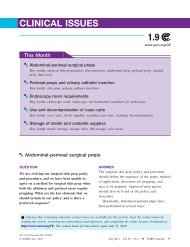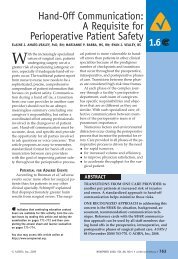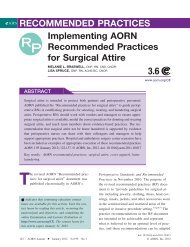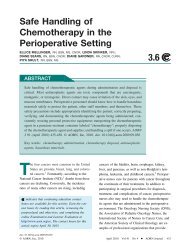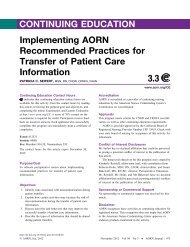Download - AORN
Download - AORN
Download - AORN
Create successful ePaper yourself
Turn your PDF publications into a flip-book with our unique Google optimized e-Paper software.
CLINICAL ISSUES1.7www.aorn.org/CEThis Monthf ff fFormalin storage and handlingKey words: formalin, formaldehyde, specimen handling.Immediate-use sterilizationKey words: flash sterilization, immediate-use sterilization.f fPrecautions for treating patients with multidrug-resistant organismsKey words: multidrug-resistant organisms, MDRO, methicillin-resistant Staphylococcus aureus,MRSA.f ff fCleaning privacy curtainsKey words: environmental cleaning, privacy curtains, laundering, commercial laundry.Informed consentsKey words: surgical consent, implants, brand names, generic names.f fFormalin storage and handlingQUESTIONTo save time between procedures, some of thenurses at my facility bring specimen containersthat are already filled with formalin into theORs. I think this is an unsafe practice and wouldlike to stop it. Does <strong>AORN</strong> have any recommendationsregarding formalin?ANSWER<strong>AORN</strong> does address formalin storage and safetyin “Recommended practices for the care andhandling of specimens in the perioperative environment.”1 <strong>AORN</strong>’s recommendations arebased on the Occupational Safety and HealthAdministration (OSHA) standard 29 CFR1910.1048, which protects workers from exposureto formaldehyde. 2Formaldehyde is a colorless, strong-smellinggas. 3 Formalin is an aqueous solution that contains37% formaldehyde and water. 3 Perioperativepersonnel can be exposed to formaldehydeas a vapor, or formaldehyde can be absorbedindicates that continuing education contact hours are available for this activity. Earn the contact hours byreading this article, reviewing the purpose/goal and objectives, and completing the online Learner Evaluation athttp://www.aorn.org/CE. The contact hours for this article expire May 31, 2014.doi: 10.1016/j.aorn.2011.02.006© <strong>AORN</strong>, Inc, 2011 May 2011 Vol 93 No 5 ● <strong>AORN</strong> Journal 619
May 2011 Vol 93 No 5 CLINICAL ISSUESthrough the skin as a liquid. Formaldehyde is a carcinogenthat is linked to nasal cancer and lung cancer,and is a sensitizing agent that can cause an immunesystem response on initial exposure. 4 Acuteexposures to airborne concentrations greater than0.1 ppm are highly irritating to the eyes, nose, andthroat, and can cause coughing and wheezing. Subsequentexposure may cause severe allergic reactionsof the skin, eyes, and respiratory tract. Longtermexposure to low levels of formaldehyde in theair or on the skin can cause asthma-like respiratoryproblems and skin irritation, such as dermatitis anditching. Pulmonary edema has been diagnosed afterexposures to 50 ppm. A 30-minute exposure to100 ppm is immediately dangerous to health andcan be fatal. These levels can be generated by smallformaldehyde spills of only 1 pint or less, even inventilated areas. 4 Blindness can result from splashesin the eyes, and dermal contact causes varying degreesof reactions, including sensitization. 5For these reasons, the safest approach is to dispenseand store formalin in a separate, wellventilatedroom in a centralized location other thanthe OR. The room should have a ventilation systemthat incorporates negative pressure and an exhausthood. 1,3 The material safety data sheet for formalinshould be kept in this room for reference in case ofan accidental spill or injury. 1,6,7 Individual specimencontainers can be filled and stored under controlledconditions close to eyewash, cleanup, and decontaminationfacilities. Using this process minimizesthe risks of hazardous spills or injuries.The OSHA standard requires that employers select, provide, and maintain personal protectiveequipment, including goggles, faceshields, aprons, impervious clothing, andgloves 5 ; ensure that employees use the personal protectiveequipment to prevent skin and eye contactwith formaldehyde 5 ; provide emergency showers 4,5 ; provide eyewash facilities in the immediatework area 4,5 ; label all containers of formalin 5 ; and provide employee education and training thatincludes safe handling, containment andcleanup of a spill, and other measures to minimizerisk of exposure. 1,5<strong>AORN</strong> recommended practices and OSHA standardsshould be followed to minimize hazardousexposure to formalin. The material safety data sheetshould be consulted in the event of a spill for firstaid treatment. 2,7 An emergency clean up protocolshould be included in a policy and procedure. 2,7Formalin should be disposed of according to stateand local regulations. 7MARY J. OGGMSN, RN, CNORPERIOPERATIVE NURSING SPECIALIST<strong>AORN</strong> CENTER FOR NURSING PRACTICEReferences1. Recommended practices for the care and handling ofspecimens in the perioperative environment. In: PerioperativeStandards and Recommended Practices. Denver,CO: <strong>AORN</strong>, Inc; 2011:283-290.2. Formaldehyde: 1910.1048. Occupational Safety andHealth Administration. http://www.osha.gov/pls/oshaweb/owadisp.show_document?p_tableSTANDARDS&p_id10075. Accessed January 7, 2011.3. Guidelines for protecting the safety and health of healthcare workers. National Institute for Occupational Safetyand Health. http://www.cdc.gov/niosh/docs/88-119/pdfs/88-119.pdf. Accessed January 7, 2011.4. Substance technical guidelines for formalin. 29 CFR1910.1048 App A. September 1988. Occupational Safetyand Health Administration. http://www.osha.gov/pls/oshaweb/owadisp.show_document?p_tableSTANDARDS&p_id10076. Accessed January 7, 2011.5. Recommended practices for a safe environment of care. In:Perioperative Standards and Recommended Practices. Denver,CO: <strong>AORN</strong>, Inc; 2011:215-236.6. OSHA directives: Enforcement procedure for occupationalexposure to formaldehyde: CPL 2–2.52.Occupational Safety and Health Administration. http://www.osha.gov/pls/oshaweb/owadisp.show_document?p_tableDIRECTIVES&p_id1566. Accessed January7, 2011.7. OSHA fact sheet: What is formaldehyde? OccupationalSafety and Health Administration. http://www.osha.gov/OshDoc/data_General_Facts/formaldehyde-factsheet.pdf. Accessed January 7, 2011.620 <strong>AORN</strong> Journal
CLINICAL ISSUESwww.aornjournal.orgf fImmediate-use sterilizationQUESTIONRecently, I needed to run a flash sterilizationcycle for a pair of scissors and a suction tip. Isterilized the two items together in the samepan for a sterilization cycle of three minuteswith no dry time and no cooling time. My coworkerinformed me that this was incorrectbecause hinged instruments and instrumentswith lumens must be sterilized for 10 minutes.I was under the impression that as long asthere were fewer than 10 instruments, itemscould be sterilized on a flash sterilization cycleof three minutes. What is the proper amountof time for flash sterilization of surgicalinstruments?ANSWERSterilization time is determined by several factors,including the porosity of the instrument, the complexityof the instrument, the presence of a lumen,the manufacturer’s instructions, and the type of sterilizer.1 The number of instruments does not determinethe amount of time required for sterilization.Historically, the term flash sterilization hasbeen used to describe shortened sterilization cyclesduring which unwrapped medical instrumentsare placed in a rigid container, subjected to steamexposure at a specific temperature for a preciselydefined period of time followed by a reduced orno dry time, delivered directly to the point of useunder aseptic conditions, and used promptly withoutbeing stored. The term flash sterilization isproblematic, however, because the parameters ofa shortened cycle vary based on the sterilizer, thedevice being sterilized, the load composition, andother factors.<strong>AORN</strong> has endorsed a multisociety positionstatement on immediate-use steam sterilization. 2This consensus document represents the evidencebasedopinions of key organizations, accreditationbodies, and agencies, including <strong>AORN</strong>, the Associationfor the Advancement of Medical Instrumentation,the Accreditation Association for AmbulatoryHealth Care, the Association forProfessionals in Infection Control and Epidemiology,the ASC Quality Collaboration, and the InternationalAssociation of Healthcare Central ServiceMateriel Management. Discussion in theposition statement concludes that, although theprocess is sound, the term flash sterilization isantiquated and does not fully describe the shortersterilization cycles currently in use to process instruments.Likewise, it does not encompass thecritical steps of cleaning, decontamination, andaseptic transport that must accompany any sterilizationcycle. These processes in total are moreaccurately reflected and described by the termimmediate-use sterilization. 2Immediate-use sterilization should be kept to aminimum, performed in a controlled manner, andused only in selected clinical situations (eg, whenthere is insufficient time to process the item bythe preferred wrapped or container method). Allitems should be subjected to the decontaminationprocesses described in <strong>AORN</strong>’s “Recommendedpractices for cleaning and care of surgical instrumentsand powered equipment.” 3 Items should besterilized for immediate use only if all of the followingrequirements are met:The device manufacturer’s written instructionson cycle type, exposure times, temperaturesettings, and drying times (if recommended)are available.Items are disassembled and thoroughly cleanedwith detergent and water to remove soil, blood,body fats, and other substances.Lumens are brushed and flushed under waterwith a cleaning solution and rinsed thoroughly.Items are placed in a closed sterilization containeror tray that is validated for immediateusesterilization. The items must be placed ina manner that allows steam to contact allsurfaces.<strong>AORN</strong> Journal 621
May 2011 Vol 93 No 5 CLINICAL ISSUES Measures are taken to prevent contaminationduring transfer to the sterile field. Sterilized items are used immediately and arenot stored for use at a later time. 1Immediate-use sterilization cycles should bemonitored to verify that the parameters requiredfor sterilization (eg, three minutes at 270° F to275° F [132° C to 135° C]) have been met.Documentation of cycle information and monitoringresults should be maintained in a log,electronic or manual, to provide tracking of theimmediate-use sterilized item(s) to the individualpatient. 1It is important to understand that there is adifference in sterilization time between a gravitydisplacementsterilizer, in which incoming airdisplaces residual air through a port or drainnear the bottom of the sterilizer chamber, 1 anda prevacuum steam sterilizer, in which air isremoved from the chamber and load via a seriesof pressure and vacuum excursions. 1 A prevacuumsterilizer facilitates air removal andaids steam penetration; for this reason, the requiredexposure time may be reduced. 4When health care providers use a gravitydisplacementsterilizer, metal or nonporous items should be sterilizedfor three minutes at 270° F to 275° F. metal items with lumens, porous items (eg,rubber, plastic, instrument tape), and complexdevices (eg, powered instruments) should besterilized for 10 minutes at 270° F to 275° F. 4When a prevacuum sterilizer is used, metal or nonporous items should be sterilizedfor three minutes at 270° F to 275° F. metal items with lumens and porous itemsshould be sterilized for four minutes at 270° For three minutes at 275° F. 4When health care providers use rigid immediate-usesterilization containers, all manufacturers’recommendations should be followed. In someinstances, instruments with lumens, poweredequipment, and porous items cannot be processedby this method because of potential difficultieswith air removal and steam penetration. 4Manufacturer’s recommendations should beverified before sterilization of specialty instrumentsand devices, such as drills, because extendedexposure times may be required. Somedevices may also necessitate a drying time to ensurelongevity and proper performance. As well,certain manufacturers of such devices recommendagainst immediate-use sterilization. 4These parameters are intended as generalguidelines. Sterilization time is not determinedby the number of instruments. It is determinedby the porosity of the instrument, the complexityof the instrument, the presence of a lumen,the manufacturer’s instructions, and the type ofsterilizer being used. The sterilizer manufacturer’swritten instructions and the device manufacturer’swritten instructions should alwaysbe followed. 4SHARON A. VAN WICKLINMSN, RN, CNOR, CRNFA, CPSN, PLNCPERIOPERATIVE NURSING SPECIALIST<strong>AORN</strong> CENTER FOR NURSING PRACTICEReferences1. Recommended practices for sterilization in the perioperativepractice setting. In: Perioperative Standards andRecommended Practices. Denver, CO: <strong>AORN</strong>, Inc;2011:463-485.2. Association for the Advancement of Medical Instrumentation,Accreditation Association for Ambulatory HealthCare, <strong>AORN</strong>, Association for Professionals in InfectionControl and Epidemiology, ASC Quality Collaboration,International Association of Healthcare Central ServiceMateriel Management. Immediate-use steam sterilization.Association for the Advancement of Medical Instrumentation.https://www.aami.org/publications/standards/ST79_Immediate_Use_Statement.pdf. Accessed February3, 2011.3. Recommended practices for cleaning and care of surgicalinstruments and powered equipment. In: PerioperativeStandards and Recommended Practices. Denver, CO:<strong>AORN</strong>, Inc; 2011:429-452.4. ANSI/AAMI ST79: 2010—Comprehensive Guide toSteam Sterilization and Sterility Assurance in HealthCare Facilities. Arlington, VA: Association for the Advancementof Medical Instrumentation; 2010:83-84.622 <strong>AORN</strong> Journal
CLINICAL ISSUESwww.aornjournal.orgf fPrecautions for treating patients withmultidrug-resistant organismsQUESTIONOur perioperative team has been discussingproper care of a patient with methicillinresistantStaphylococcus aureus (MRSA) whois undergoing surgery. Is there anything specificwe should do differently than we do forroutine procedures? Is there anything weshould know and do differently when weturn over the room between procedures?ANSWEREveryone who participates in procedures in whichthe patient is suspected of being infected or colonizedwith MRSA should follow contact isolationprecautions for MRSA. Transmission can occurdirectly from infected or colonized patients orindirectly from contaminated equipment, supplies,and environmental surfaces in the patient carearea. Personal protective equipment for proceduresthat involve MRSA includes a gown andgloves during patient transport, and a mask,gown, and gloves for a person entering a roomwhere sterile supplies are opened. Personal protectiveequipment should be worn during the entireprocedure. 1The protocol for cleaning is different than forroutine OR room turnover. Surfaces that requirecleaning include those that come in contact withthe patient who may be infected or colonized witha multidrug-resistant organism (MDRO). Multidrug-resistantorganisms are predominantly bacteriathat are resistant to one or more classes ofantimicrobial agents. 1 Methicillin-resistant Saureusis classified as an MDRO. Enhanced cleaningof frequently touched surfaces (eg, computerkeyboards, telephones, handheld devices, charts,door knobs/push plates) should be performed afterhealth care providers care for patients withMDROs. Trained and dedicated environmentalservices personnel may be needed to prevent thetransmission of MRSA to health care personneland patients. They also should wear personal protectiveequipment while cleaning. 2The use of disinfectants that are effectiveagainst S aureus will very likely be effectiveagainst MRSA. Disinfectants kill or inactivatemicroorganisms and prevent them from growing.Disinfectants have little effect on dirt, soil,or dust. Disinfectants are regulated by the USEnvironmental Protection Agency (EPA) andare considered the proper product to use. 3,4 Alist of EPA-registered disinfectants that are effectiveagainst MRSA is available on the EPA web site athttp://www.epa.gov/oppad001/list_h_mrsa_vre.pdf. 5Check the disinfectant label for the list ofmicroorganisms that the product will kill. It isimportant to follow the disinfectant’s labeled instructionsfor how to apply the product to a surface, safety of the disinfectant for the surface beingcleaned, the product contact time, whether the surface needs to be cleaned beforethe disinfectant is applied, whether the product has to be diluted beforeuse, and precautions that need to be taken when applyingthe product (ie, gloves, gown, eyewear,good ventilation). 3Protecting employees and the environment aswell as caring for the patient is important. Microorganismsmay be acquired by health carepersonnel when they care for patients or comein contact with contaminated surfaces in patientcare areas. 6 Caring for a patient with MRSArequires personal protective equipment, use ofenhanced cleaning procedures, and use of theappropriate cleaning product to disinfect theenvironment the patient has occupied.<strong>AORN</strong> Journal 623
May 2011 Vol 93 No 5 CLINICAL ISSUESJOAN BLANCHARDMSS, BSN, RN, CNOR, CICPERIOPERATIVE NURSING SPECIALIST<strong>AORN</strong> CENTER FOR NURSING PRACTICEReferences1. Guide to the Elimination of Methicillin-Resistant Staphylococcusaureus (MRSA) Transmission in Hospital Settings.Washington, DC: Association for Professionals inInfection Control and Epidemiology; 2007:1-64. http://www.positivedeviance.org/pdf/publications/APIC.pdf.Accessed January 7, 2011.2. Siegel JD, Rhinehart E, Jackson M, Chiarello L. Managementof Multi-drug Resistant Organisms in Healthcare Settings,2006. Atlanta, GA: Centers for Disease Control and Prevention;2006:1-75. http://www.cdc.gov/ncidod/dhqp/pdf/ar/mdroGuideline2006.pdf. Accessed January 7, 2011.3. Environmental cleaning and disinfecting for MRSA.Centers for Disease Control and Prevention. http://www.cdc.gov/mrsa/environment. Accessed January 7, 2011.4. Recommended practices for environmental cleaning inthe perioperative setting. In: Perioperative Standards andRecommended Practices. Denver, CO: <strong>AORN</strong>, Inc;2011:237-250.5. List H: EPA’s registered products effective against methicillinresistant Staphylococcus aureus (MRSA) and vancomycinresistant Enterococcus faecalis or faecium(VRE). January 9, 2009. US Environmental ProtectionAgency Office of Pesticide Programs. http://www.epa.gov/oppad001/list_h_mrsa_vre.pdf. Accessed January7, 2011.6. Recommended practices for hand hygiene in the perioperativesetting. In: Perioperative Standards and RecommendedPractices. Denver, CO: <strong>AORN</strong>, Inc; 2011:73-86.f fCleaning privacy curtainsQUESTIONI am the manager of a new ambulatory surgerycenter that opened six months ago. Wehave not cleaned the privacy curtains in ourpreoperative and postoperative areas and needto develop a policy and procedure for doingthis. How often do the privacy curtains need tobe cleaned? Is it acceptable to have themsteam cleaned and leave them hanging to dry,or do we have to take them down?ANSWERAccording to the American Society for HealthcareEnvironmental Services of the AmericanHospital Association, privacy curtains shouldbe cleaned any time there is visible dust or soiland as a part of the terminal cleaning processwhenever an area has been occupied by a patientwho has been on contact or droplet precautions.1,2 To prevent cross contamination, theprivacy curtains should be taken down immediatelyafter an area has been occupied by a patientwho has been on isolation precautions,and clean curtains should be hung before thenext patient occupies the area. Conversely,freshly laundered privacy curtains should behung immediately before an immunosuppressedpatient will be occupying the area.If the curtains are made from a nonporous material(eg, plastic), the edges are high-touch areasand should be included in the daily disinfecting/cleaning procedure. 1 If the curtains are fabric andthere is no visible dust or soil, some of the followingconsiderations should be taken into accountfor determining the frequency of cleaning:volume of surgical procedures performed permonth, types of procedures performed in the facility,patient population, traffic in the area, andthe number of visitors.Privacy curtains should be removed and sentout to a commercial laundry to ensure they aredisinfected and free of vegetative pathogens (ie,hygienically clean). According to the Centers forDisease Control and Prevention guidelines,“Laundering cycles consist of flush, main wash,bleaching, rinsing, and souring. . . . The antimicrobialaction of the laundering process resultsfrom a combination of mechanical, thermal, andchemical factors.” 2(p100-101) Adding a mild acid tothe final rinse cycle is known as “souring” andresults in a rapid shift in the pH from an alkalinelevel to an acidic level that further inactivatessome microorganisms. 2The guidelines also state that large-surfacecleaning methods that produce mists or aerosolor disperse dust in patient-care areas should be624 <strong>AORN</strong> Journal
CLINICAL ISSUESwww.aornjournal.orgavoided. 2 It is not appropriate to steam thecurtains and leave them hanging because of theprobability of aerosolization and dispersion ofdust and the risk of burns to the personnel usingthe steamer. There also is a risk for inconsistencybecause the heat from the steam may not reach allareas of the curtain and may not provide enoughheat to destroy microorganisms. Steam cleaningwould not include the recommended bleachingand rinse cycles.When purchasing privacy curtains and developingcleaning policies, perioperative managersshould be aware of the manufacturer’s recommendationsfor cleaning. State regulations or accreditingstandards may dictate procedures for launderingand cleaning cycles. Knowing the fabriccontent of the privacy curtains is important todetermine the method for cleaning. For example,dry cleaning is not considered to be effective inreducing the numbers of bacteria and viruses oncontaminated fabric surfaces. 2 Fabric content alsois important because of the tendencies of microorganismsto bind with certain fabrics more thanothers. One study indicates that S aureus andPseudomonas aeruginosa can bind to acrylic, polyester,and wool at very high ratios. 3 Other studieshave shown that staphylococci, enterococci, andfungus can survive on fabric for days or weeks andhave a tendency to survive longer on polyester thanon cotton. 4,5 A sufficient inventory of privacy curtainsshould be purchased to allow immediate replacementwhen necessary.BONNIE G. DENHOLMMS, BSN, RN, CNORPERIOPERATIVE NURSING SPECIALIST<strong>AORN</strong> CENTER FOR NURSING PRACTICEReferences1. FAQ section: how often should privacy curtains becleaned? American Society for Healthcare EnvironmentalServices of the American Hospital Association.http://www.ashes.org/ashes_app/learn/in_focus/faqs/privacy_curtains_1.jsp. Accessed November 11, 2010.2. Sehulster L, Chinn RYW, Arduino MJ, et al. Guidelinesfor Environmental Infection Control in Health-CareFacilities: Recommendations of CDC and the HealthcareInfection Control Practices Advisory Committee (HICPAC).Chicago IL: American Society for Healthcare Engineering/American Hospital Association; 2004. http://cdc.gov/ncidod/dhqp/pdf/guidelines/Enviro_guide_03.pdf. Accessed January7, 2011.3. Takashima M, Shirai F, Sageshima M, Ikeda N, OkamotoY, Dohi Y. Distinctive bacteria-binding property of clothmaterials. Am J Infect Control. 2004;32(1):27-30.4. Neely AN, Orloff MM. Survival of some medically importantfungi on hospital fabrics and plastics. J ClinMicrobiol. 2001;39(9):3360-3361.5. Neely AN, Maley MP. Survival of enterococci andstaphylococci on hospital fabrics and plastic. J ClinMicrobiol. 2000;38(2):724-726.f fInformed consentsQUESTIONA group of surgeons at our facility want thebrand name of implants, such as dialysis catheters,to be written on the surgical consent. Itstates in our policy and procedure that the genericname (eg, implantable hemodialysis catheter)is used instead. What is <strong>AORN</strong>’s position?What regulatory agencies provide guidelines forupdating the consent policy and procedure?ANSWER<strong>AORN</strong> does not have a specific position related tothe use of brand names of products on the surgicalconsent form. Your facility may have createda policy because there have been instances inwhich the wrong brand name was written on theconsent, which causes confusion and delays insurgery. As long as the consent adheres to federaland state laws, the particular wording of the consentis the decision of the facility.The Centers for Medicare & Medicaid Servicesoffers the following guidelines for elements toinclude in an informed consent policy, 1 whichalso should be included in the hospital’s surgicalinformed consent policy:who may obtain the patient’s informedconsent;<strong>AORN</strong> Journal 625
May 2011 Vol 93 No 5 CLINICAL ISSUES which procedures require informed consent; the circumstances under which surgery is consideredan emergency and may be undertakenwithout an informed consent; the circumstances under which a patient’s representative,rather than the patient, may giveinformed consent for surgery; the content of the informed consent form andinstructions for completing it; the process used to obtain informed consent,including how informed consent is to be documentedin the medical record; mechanisms to ensure that the informed consentform is properly executed and is in thepatient’s medical record before the onset ofsurgery (except in the case of emergency surgery);and how a properly executed informed consentform that was obtained outside the hospital isincorporated into the patient’s medical recordbefore surgery.The Centers for Medicare & Medicaid Servicesrecently asked the Joint Commission to clarify itsrequirements for documenting informed consent. 2In response, the Joint Commission has revisedStandard RC.02.01.01, Element of Performance 4,by adding the following text to the existing statementon informed consent:Note: The properly executed informed consentis placed in the patient’s medical record priorto surgery, except in emergencies. A properlyexecuted informed consent contains documentationof a patient’s mutual understanding of andagreement for care, treatment or servicesthrough written signature, electronic signature,or, when a patient is unable to provide a signature,documentation of the verbal agreementby the patient or surrogate decision maker. 2(p1)It is the responsibility of the facility to establishpolicy for consent requirements. The surgeonis responsible for obtaining the consentand exchanging information with the patientabout the planned procedure. The role of theperioperative nurse is to confirm that the consentis present in the health record and servesas a witness to the patient’s signature shouldthe need arise. As the patient’s advocate, perioperativenurses are instrumental in ensuringthat the informed consent is included in theoverall plan of care.ROBIN CHARDPhD, RN, CNORPERIOPERATIVE NURSING SPECIALIST<strong>AORN</strong> CENTER FOR NURSING PRACTICEReferences1. Revisions to the hospital interpretive guidelines forinformed consent. Centers for Medicare & MedicaidServices. April 13, 2007. http://www.cms.hhs.gov/SurveyCertificationGenInfo/downloads/SCLetter07-17.pdf. Accessed January 7, 2011.2. Clarification: Documentation of informed consent. October27, 2010. Joint Commission Online. http://www.jointcommission.org/assets/1/18/jconline_Oct_27_10.pdf.Accessed February 9, 2011.The authors of this column have no declared affiliations that could be perceived as posing potentialconflicts of interest in the publication of this article.626 <strong>AORN</strong> Journal
LEARNER EVALUATIONCONTINUING EDUCATION PROGRAMClinical Issues1.7www.aorn.org/CEThis evaluation is used to determine the extent towhich this continuing education program metyour learning needs. The evaluation is printedhere for your convenience. To receive continuing educationcredit, you must complete the LearnerEvaluation online at http://www.aorn.org/CE. Ratethe items as described below.PURPOSE/GOALTo educate perioperative nurses about providing safenursing care throughout the perioperative continuum.OBJECTIVESTo what extent were the following objectives of thiscontinuing education program achieved?1. Discuss practices that could jeopardize safety inthe perioperative area. Low 1. 2. 3. 4. 5. High2. Discuss common areas of concern that relate toperioperative best practices. Low 1. 2. 3. 4. 5.High3. Describe implementation of evidence-based practicein relation to perioperative nursing care.Low 1. 2. 3. 4. 5. HighCONTENT4. To what extent did this article increase yourknowledge of the subject matter? Low 1. 2. 3. 4. 5.High5. To what extent were your individual objectivesmet? Low 1. 2. 3. 4. 5. High6. Will you be able to use the information from thisarticle in your work setting? 1. Yes 2. No7. Will you change your practice as a result of readingthis article? (If yes, answer question #7A. Ifno, answer question #7B.)7A. How will you change your practice? (Select allthat apply)1. I will provide education to my team regardingwhy change is needed.2. I will work with management to change/implement a policy and procedure.3. I will plan an informational meeting with physiciansto seek their input and acceptance ofthe need for change.4. I will implement change and evaluate the effectof the change at regular intervals until thechange is incorporated as best practice.5. Other:7B.If you will not change your practice as a result ofreading this article, why? (Select all that apply)1. The content of the article is not relevant to mypractice.2. I do not have enough time teach others aboutthe purpose of the needed change.3. I do not have management support to make achange.4. Other:8. Our accrediting body requires that we verify thetime you needed to complete the 1.7 continuingeducation contact hour (102-minute) program:This program meets criteria for CNOR and CRNFA recertification, as well as other continuing education requirements.<strong>AORN</strong> is accredited as a provider of continuing nursing education by the American Nurses Credentialing Center’s Commission on Accreditation.<strong>AORN</strong> recognizes these activities as continuing education for registered nurses. This recognition does not imply that <strong>AORN</strong> or the American Nurses Credentialing Centerapproves or endorses products mentioned in the activity.<strong>AORN</strong> is provider-approved by the California Board of Registered Nursing, Provider Number CEP 13019. Check with your state board of nursing for acceptance of thisactivity for relicensure.Event: #11012; Session: #4065, Fee: Members $8.50 Nonmembers $17The deadline for this program is May 31, 2014.Each applicant who successfully completes this program can immediately print a certificate of completion.© <strong>AORN</strong>, Inc, 2011 May 2011 Vol 93 No 5 ● <strong>AORN</strong> Journal 627


